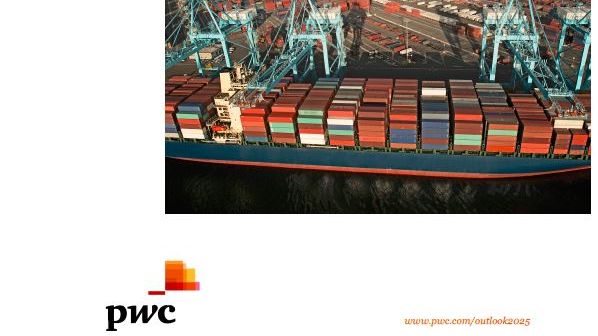
Press release -
Global transport infrastructure investment predicted to reach unprecedented levels - PwC
| Date | 2 October 2015 (Singapore) |
| Contact |
Natalie Choo Tel: +65 6263 4309 Mobile: +65 9738 1415 Email: natalie.yl.choo@sg.pwc.com |
Global transport infrastructure investment predicted to reach unprecedented levels - PwC
New PwC report forecasts cumulative transport infrastructure investment to 2025 in the Asia Pacific Region to be over US$8 trillion.
Singapore, 2 October 2015 – Transport infrastructure investment is projected to increase at an average annual rate of about 5% worldwide between 2014 and 2025, according to analysis released today by PwC.
The analysis on transport infrastructure spending to 2025, for which Oxford Economics provided research support, estimates the scale of current transport infrastructure investment and assesses the prospects for future investment from now to 2025.
Asia-Pacific remains by far the largest transport infrastructure market, with investments increasing from US$557bn per year to nearly US$900bn per year in 2025, while Sub-Saharan Africa is expected to have the fastest average annual growth rate of over 11%. Transport infrastructure investment levels in Western Europe are expected to take a long time to recover due to continual fiscal austerity – returning only to 2008 levels in 2022.
Investment in sea ports is predicted to grow the fastest at 5.8% on average per year over the forecast period (led by, for example, large investments in Indonesia), while airport investments are expected to slow down to an annual growth rate of 2.6%.
Roads will likely remain the biggest area of investment, especially for growth markets. This is partly due to the rise in prosperity and, hence, car ownership in developing countries.
Railways, by contrast, are forecast to see relatively strong growth in advanced economies with mature transport markets like Western Europe where there is a growing opinion in favour of public transport – and particularly in the UK and Spain where high-speed networks are expected to undergo further development.
In Singapore, the government has increased spending on transport infrastructure in recent years and this is projected to continue in the future as major projects across all transport modes are further developed and completed. These include for rail, the completion of the Downtown Line, further extensions to the existing MRT lines and the Cross Island Line; for air, Terminals 4 and 5 and runway 3; and for ports, the relocation of the main port. These investments will help to maintain Singapore as a regional hub for both people and freight. Further, they will help to achieve the LTA’s vision for public transport in 2030 with Singaporeans benefiting as commuting will be made easier, quicker and more comfortable.
Asia-Pacific
Forecasts indicate that cumulative transport infrastructure investment in the region will exceed US$8 trillion up to 2025. Large-scale development of transport networks will likely continue in many Asia-Pacific economies, given the shift in economic power from the West to the East, the rise in Asian wealth and rapid urbanisation. Significant investment in road infrastructure to accommodate ever more cars, along with investment in public transport infrastructure to relieve congestion in urban areas, is expected. Strong growth in sea port infrastructure is also anticipated to support expansion in international trade.
Mark Rathbone, Asia-Pacific Capital Projects and Infrastructure Leader, PwC concludes:
“Transport infrastructure is a priority sector for investment by governments and the private sector in the region. It is vitally important to invest in transport infrastructure to enable the efficient movement of labour and freight within cities and between countries. Transport networks need significant investment to contribute to the achievement of the ASEAN goals of closer economic integration and increased regional trade.”
“Our forecasts present a positive picture of a growing market for transport infrastructure, but it is important to ensure that this money is invested carefully and wisely, delivering increasing value to the funders, including all of us as users, taxpayers or investors.”
ENDS
Notes to Editors
- 1.Download a copy of the analysis here.
- 2.This report from PwC, with research by Oxford Economics, is part of an overall package of materials that provides the first consistent data analysing projected capital project and infrastructure spending across the globe. For investors, public officials and companies planning capital investments, it highlights the sectors and countries expected to benefit from this investment resurgence. And it provides insight into the factors driving the expected investment growth. In developing this analysis, Oxford Economics used data sets to provide consistent, reliable, and repeatable measures of projected capital project and infrastructure spending by sector and country. Historical spending data is drawn from government and multinational organisations' statistical sources. Projections are based on proprietary economic models developed by Oxford Economics at the country level. The results for this report have been estimated using the following underlying data sources: World Health Organisation, UNESCO, World Bank, Annual Capital Expenditures Survey, Association of American Ports, Edison Electrical Institute, Office of Highway Policy Information, Federal Highways Authority, Department of Transportation, National Clearinghouse of Educational Facilities, Department of Education and Oxford Economics. The analysis, completed over the first half of 2015, incorporates all available information at that time.
Topics
Categories
About PwC
PwC helps organisations and individuals create the value they’re looking for. We’re a network of firms in 157 countries with more than 195,000 people who are committed to delivering quality in assurance, tax and advisory services. Tell us what matters to you and find out more by visiting us at www.pwc.com.
PwC refers to the PwC network and/or one or more of its member firms, each of which is a separate legal entity. Please see www.pwc.com/structure for further details.
© 2015 PricewaterhouseCoopers. All rights reserved.


